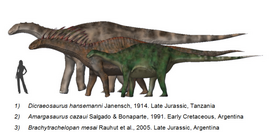叉龙科
| 叉龙科 | |
|---|---|

| |
| 阿马加龙 | |
| 科学分类 | |
| 界: | 动物界 Animalia |
| 门: | 脊索动物门 Chordata |
| 纲: | 蜥形纲 Sauropsida |
| 总目: | 恐龙总目 Dinosauria |
| 目: | 蜥臀目 Saurischia |
| 亚目: | †蜥脚形亚目 Sauropodomorpha |
| 下目: | †蜥脚下目 Sauropoda |
| 演化支: | †沉重龙类 Gravisauria |
| 演化支: | †真蜥脚类 Eusauropoda |
| 演化支: | †新蜥脚类 Neosauropoda |
| 总科: | †梁龙总科 Diplodocoidea |
| 演化支: | †梁龙形类 Diplodocimorpha |
| 演化支: | †鞭尾类 Flagellicaudata |
| 科: | †叉龙科 Dicraeosauridae Janensch, 1929 |
| 属 | |
叉龙科(学名:Dicraeosauridae)是蜥脚下目梁龙超科的一个演化支,与梁龙科同属于鞭尾类底下的姊妹分类单元。叉龙科包含了阿马加龙、春雷龙、叉龙、短颈潘龙等属。标本在北美洲、南美洲、非洲、亚洲都有发现。[1]地质年代约从侏罗纪早期或中期到白垩纪早期。[2][3][4]叉龙科可能在新蜥脚类发展的非常早期就演化出来。[4]只有少数物种幸存至白垩纪,其中最年轻的是阿马加龙。[5]
1914年,德国古生物学家沃纳·亚嫩施在坦桑尼亚发现的叉龙叙述中一同提到了叉龙科。[6]叉龙科因为牠们相对短的颈部和较小的体型,而在蜥脚类中相当独特。[2]
这个演化支是个单系群,并由系统发生学提供有力的支持,一共有13个明确的共有衍征将本科物种关联在一起。[5]牠们于侏罗纪中期自梁龙超科中分支出来,这点能根据冈瓦纳大陆还相连时的南美及东非叉龙科的多样性得到证实。[5]然而,春雷龙在系统发生学的位置上仍有争议,牠是叉龙科唯一的北美洲物种。有些认为牠属于基础叉龙科,其他则认为牠属于梁龙科。[5][7]春雷龙在叉龙科或梁龙科的支序位置,对于研究叉龙科的演化具有重要的生物地理学意义。[8]
分类
[编辑]
叉龙科属于梁龙超科底下的一个分支,并与梁龙科互成姊妹群。过去二十年以来,该科已知的物种数增加至原本的两倍以上。[5]春雷龙在叉龙科的位置仍没有明确的共识,[5][7]有些系统发生学研究发现牠可能属于基础梁龙科而非叉龙科。[7]一项2015年的分析甚至发现难觅龙、糙节龙也属于叉龙科。[9]而2016年对阿马格巨龙的重新检视也将牠纳入叉龙科中。[10]2018年,新属皮尔马图埃龙[11]和灵武龙[4]被叙述。

叉龙科不同于其姊妹群梁龙科、以及其他大部分蜥脚类的特征在于相对较小的体型和短颈部。[12]叉龙科是单系群新蜥脚类中的一个先进演化支,后者以普遍的巨大化趋势闻名,但前者缩小的体型成为后者中的例外。[13]
系统发生学
[编辑]已经提出了几个不同的系统发生学分析,但科内关系仍未得到解决。春雷龙的位置有不同变动(基础叉龙科或基础梁龙科)。以下演化树取自Tschopp等人(2015):[9]
| ||||||||||||||||||||||||||||||||||
Tschopp将两个传统上认为不属于叉龙科的属:难觅龙和糙节龙列入。险路糙节龙的标本过于破碎,只有几块骨头可供研究,包含尺骨、部分肩胛骨、部分背椎、一个远端桡骨和一些掌骨。多爪难觅龙的化石材料也有限,仅有一些肢骨,因此Tschopp的分析被认为是初步的评估。[9]
许多研究并未包含进春雷龙,例如Sereno等人(2007)[12]和JD Harris(2006)[8];其他研究则将春雷龙纳入叉龙科,例如Whitlock(2010)[5]、Salgado等人(2006)[14]。
古生物学
[编辑]觅食习性
[编辑]作为蜥脚类,叉龙科是专门的植食性动物。根据牠们相对较小的颈部和头骨,可以推测叉龙科和梁龙科主要在接近地面或中等高处觅食。[5][12]叉龙科中只有叉龙保存了完整的牙齿。这使古生物学家很难将叉龙科与梁龙科的觅食行为作出明确的比较。[15]与已知的亲缘物种相比,叉龙的独特之处在于上颌和下颌牙齿数量相等,而下颌牙齿汰换速率较慢。[15]
解剖学
[编辑]叉龙科以这些特征著称:小体型、短颈部、加长/加高的神经棘。牠们体长介于10至13米。[16]在短颈部方面,以短颈潘龙的颈部最短(短于其他叉龙科40%)、叉龙次之。[17]在神经棘方面,叉龙的神经棘高度中等,而在阿马加龙、巴哈达龙达到极致,神经棘极度加长变成刺状。[18]13个共有衍征例如:背椎无侧凹、鳞状骨有腹刺、亚三角形的齿骨联合等。[5]
分布和演化
[编辑]叉龙科物种主要分布于冈瓦那大陆,南美洲有短颈潘龙、阿马加龙、阿马格巨龙、皮尔马图埃龙、巴哈达龙;非洲有叉龙。北美洲的春雷龙是个例外,使牠的确切分类位置显得关键。这个演化支可能在侏罗纪中期与梁龙科分开,并扩散至冈瓦纳大陆,于东非和南美达到高度多样化。白垩纪早期的阿马加龙是已知最年轻的叉龙科。[5]2018年发表的灵武龙将叉龙科的起源再提早了100万年,代表这个演化支在比原先预料的更早之前就已经分化出来,并且将地理分布延伸至中亚,其在研究新蜥脚类的演化与古生物地理学上意义非凡。[4]
叙述年代表
[编辑]
参考资料
[编辑]- ^ Gallina, Pablo A.; Apesteguía, Sebastián; Haluza, Alejandro; Canale, Juan I. A Diplodocid Sauropod Survivor from the Early Cretaceous of South America. PLOS ONE. 2014-05-14, 9 (5): e97128. Bibcode:2014PLoSO...997128G. ISSN 1932-6203. PMC 4020797
 . PMID 24828328. doi:10.1371/journal.pone.0097128.
. PMID 24828328. doi:10.1371/journal.pone.0097128.
- ^ 2.0 2.1 Rauhut, Oliver W. M.; Remes, Kristian; Fechner, Regina; Cladera, Gerardo; Puerta, Pablo. Discovery of a short-necked sauropod dinosaur from the Late Jurassic period of Patagonia. Nature. 2005-06-02, 435 (7042): 670–672. Bibcode:2005Natur.435..670R. ISSN 1476-4687. PMID 15931221. doi:10.1038/nature03623.
- ^ Carabajal, Ariana Paulina; Carballido, José L.; Currie, Philip J. Braincase, neuroanatomy, and neck posture of Amargasaurus cazaui (Sauropoda, Dicraeosauridae) and its implications for understanding head posture in sauropods. Journal of Vertebrate Paleontology. 2014-06-07, 34 (4): 870–882. ISSN 0272-4634. doi:10.1080/02724634.2014.838174.
- ^ 4.0 4.1 4.2 4.3 Xing Xu; Paul Upchurch; Philip D. Mannion; Paul M. Barrett; Omar R. Regalado-Fernandez; Jinyou Mo; Jinfu Ma; Hongan Liu. A new Middle Jurassic diplodocoid suggests an earlier dispersal and diversification of sauropod dinosaurs. Nature Communications. 2018, 9 (1): Article number 2700. Bibcode:2018NatCo...9.2700X. PMC 6057878
 . PMID 30042444. doi:10.1038/s41467-018-05128-1.
. PMID 30042444. doi:10.1038/s41467-018-05128-1.
- ^ 5.00 5.01 5.02 5.03 5.04 5.05 5.06 5.07 5.08 5.09 Whitlock, John A. A phylogenetic analysis of Diplodocoidea (Saurischia: Sauropoda). Zoological Journal of the Linnean Society. 2011-04-01, 161 (4): 872–915. ISSN 1096-3642. doi:10.1111/j.1096-3642.2010.00665.x (英语).
- ^ Weishampel, DB; Dodson, P; Osmolska, H. The Dinosauria. University of California Press. 2007. ISBN 978-0520254084.
- ^ 7.0 7.1 7.2 Woodruff, D. Cary; Fowler, Denver W. Ontogenetic influence on neural spine bifurcation in Diplodocoidea (Dinosauria: Sauropoda): a critical phylogenetic character. Journal of Morphology. 2012-07-01, 273 (7): 754–764. ISSN 1097-4687. PMID 22460982. doi:10.1002/jmor.20021.
- ^ 8.0 8.1 Harris, Jerald D. The significance of Suuwassea emilieae (Dinosauria: Sauropoda) for flagellicaudatan intrarelationships and evolution. Journal of Systematic Palaeontology. 2006-01-01, 4 (2): 185–198. ISSN 1477-2019. doi:10.1017/S1477201906001805.
- ^ 9.0 9.1 9.2 Tschopp, Emanuel; Mateus, Octávio; Benson, Roger B.J. A specimen-level phylogenetic analysis and taxonomic revision of Diplodocidae (Dinosauria, Sauropoda). PeerJ. 2015-04-07, 3: e857. ISSN 2167-8359. PMC 4393826
 . PMID 25870766. doi:10.7717/peerj.857 (英语).
. PMID 25870766. doi:10.7717/peerj.857 (英语).
- ^ Gallina, Pablo Ariel. Reappraisal of the Early Cretaceous sauropod dinosaur Amargatitanis macni (Apesteguía, 2007), from northwestern Patagonia, Argentina. Cretaceous Research. 2016-09-01, 64: 79–87. doi:10.1016/j.cretres.2016.04.002.
- ^ Coria, Rodolfo A; Windholtz, Guillermo J; Ortega, Francisco; Currie, Philip J. A new dicraeosaurid sauropod from the Lower Cretaceous (Mulichinco Formation, Valanginian, Neuquén Basin) of Argentina. Cretaceous Research. 2018,. in press: 33–48. doi:10.1016/j.cretres.2018.08.019.
- ^ 12.0 12.1 12.2 Sereno, Paul C.; Wilson, Jeffrey A.; Witmer, Lawrence M.; Whitlock, John A.; Maga, Abdoulaye; Ide, Oumarou; Rowe, Timothy A. Structural Extremes in a Cretaceous Dinosaur. PLOS ONE. 2007-11-21, 2 (11): e1230. Bibcode:2007PLoSO...2.1230S. ISSN 1932-6203. PMC 2077925
 . PMID 18030355. doi:10.1371/journal.pone.0001230.
. PMID 18030355. doi:10.1371/journal.pone.0001230.
- ^ Sander, P. Martin; Christian, Andreas; Clauss, Marcus; Fechner, Regina; Gee, Carole T.; Griebeler, Eva-Maria; Gunga, Hanns-Christian; Hummel, Jürgen; Mallison, Heinrich. Biology of the sauropod dinosaurs: the evolution of gigantism. Biological Reviews of the Cambridge Philosophical Society. 2011-02-01, 86 (1): 117–155. ISSN 1469-185X. PMC 3045712
 . PMID 21251189. doi:10.1111/j.1469-185X.2010.00137.x.
. PMID 21251189. doi:10.1111/j.1469-185X.2010.00137.x.
- ^ Salgado, Leonardo; Carvalho, Ismar de Souza; Garrido, Alberto C. Zapalasaurus bonapartei, un nuevo dinosaurio saurópodo de La Formación La Amarga (Cretácico Inferior), noroeste de Patagonia, Provincia de Neuquén, Argentina. Geobios. 2006, 39 (5): 695–707. doi:10.1016/j.geobios.2005.06.001.
- ^ 15.0 15.1 Schwarz, Daniela; Kosch, Jens C. D.; Fritsch, Guido; Hildebrandt, Thomas. Dentition and tooth replacement of Dicraeosaurus hansemanni (Dinosauria, Sauropoda, Diplodocoidea) from the Tendaguru Formation of Tanzania. Journal of Vertebrate Paleontology. 2015-11-02, 35 (6): e1008134. ISSN 0272-4634. doi:10.1080/02724634.2015.1008134.
- ^ Daniela Schwarz-Wings, 10th Annual Meeting of the European Association of Vertebrate Paleontologists. Royo-Torres, R, Gascó, F, and Alcalá, L., coord. ¡Fundamental! 20: 1-290. 2012.
- ^ Rauhut O.W.M., Remes K., Fechner R., Cladera G., Puerta P. Discovery of a short-necked sauropod dinosaur from the Late Jurassic period of Patagonia. Nature. 2005, 435: 670–672.
- ^ Gallina, P.A.; Apesteguía, S.; Canale, J.I.; Haluza, A. A new long-spined dinosaur from Patagonia sheds light on sauropod defense system. Scientific Reports. 2019, 9 (1): 1392. Bibcode:2019NatSR...9.1392G. PMC 6362061
 . PMID 30718633. doi:10.1038/s41598-018-37943-3.
. PMID 30718633. doi:10.1038/s41598-018-37943-3.













